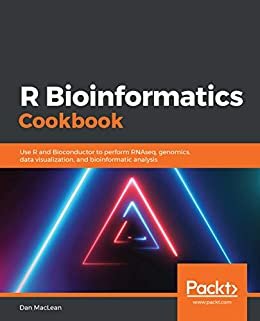
R Bioinformatics Cookbook: Use R and Bioconductor to perform RNAseq, genomics, data visualization, and bioinformatic analysis (English Edition)
- 作者
- Dan MacLean
- 语言
- 英语
- 出版社
- Packt Publishing 版次:1
- 出版日期
- 2019年10月11日
- 纸书页数
- 316页
- 电子书格式
- epub,pdf,mobi,azw3,txt,fb2,djvu
- 文件大小
- 13276 KB
- 下载次数
- 4270
- 更新日期
- 2023-05-20
- 运行环境
- PC/Windows/Linux/Mac/IOS/iPhone/iPad/iBooks/Kindle/Android/安卓/平板
内容简介
Over 60 recipes to model and handle real-life biological data using modern libraries from the R ecosystem
Key Features
Apply modern R packages to handle biological data using real-world examples
Represent biological data with advanced visualizations suitable for research and publications
Handle real-world problems in bioinformatics such as next-generation sequencing, metagenomics, and automating analyses
Book Description
Handling biological data effectively requires an in-depth knowledge of machine learning techniques and computational skills, along with an understanding of how to use tools such as edgeR and DESeq. With the R Bioinformatics Cookbook, you’ll explore all this and more, tackling common and not-so-common challenges in the bioinformatics domain using real-world examples.
This book will use a recipe-based approach to show you how to perform practical research and analysis in computational biology with R. You will learn how to effectively analyze your data with the latest tools in Bioconductor, ggplot, and tidyverse. The book will guide you through the essential tools in Bioconductor to help you understand and carry out protocols in RNAseq, phylogenetics, genomics, and sequence analysis. As you progress, you will get up to speed with how machine learning techniques can be used in the bioinformatics domain. You will gradually develop key computational skills such as creating reusable workflows in R Markdown and packages for code reuse.
By the end of this book, you’ll have gained a solid understanding of the most important and widely used techniques in bioinformatic analysis and the tools you need to work with real biological data.
What you will learn
Employ Bioconductor to determine differential expressions in RNAseq data
Run SAMtools and develop pipelines to find single nucleotide polymorphisms (SNPs) and Indels
Use ggplot to create and annotate a range of visualizations
Query external databases with Ensembl to find functional genomics information
Execute large-scale multiple sequence alignment with DECIPHER to perform comparative genomics
Use d3.js and Plotly to create dynamic and interactive web graphics
Use k-nearest neighbors, support vector machines and random forests to find groups and classify data
Who this book is for
This book is for bioinformaticians, data analysts, researchers, and R developers who want to address intermediate-to-advanced biological and bioinformatics problems by learning through a recipe-based approach. Working knowledge of R programming language and basic knowledge of bioinformatics are prerequisites. Table of Contents
Performing Quantitative RNAseq
Finding Genetic Variants With Next-Generation Sequence Data
Analyzing Gene and Protein Sequence For Domains and Motifs
Phylogenetic Analysis and Visualisation
Metagenomics
Proteomics from Spectrum to Annotation
Producing Publication and Web-Ready Visualizations
Working with Databases and Remote Data Sources
Useful Statistical and Machine Learning Methods in Bioinformatics
Programming and Analysis with Tidyverse
Building reusable workflows with packages and objects for code re-use
R Bioinformatics Cookbook: Use R and Bioconductor to perform RNAseq, genomics, data visualization, and bioinformatic analysis (English Edition) EPUB, PDF, MOBI, AZW3, TXT, FB2, DjVu, Kindle电子书免费下载。
- 你惹不起的男人(全卷共三册,知名言情小说作家天机老人携著作强势归来!豆瓣高分评价!引百万人追读!心有不甘,自命不凡,狂傲本色从未褪!)第二册 天机老人
- 邪王绝宠:全能世子妃(全书共三册,知名畅销书作家萱草经典之作,最受大众喜爱的图书之一!蝉联各大平台畅销金榜!倾城绝恋,腹黑世子转角遇到爱! ) 萱草
- 单挑吧王爷(全书共三册,超人气作家桃七七年度经典著作!大型漫画改编原著!万人追更,好评不断!情路相逢勇者胜,不是冤家不聚头!) 桃七七
- 通天之路(全卷共四册,人气言情小说作家闻松听涛超越自我的巅峰之作!点击破十亿的热销图书!网站年度言情巨献火爆来袭!身负梦想,抓住机遇,演绎开挂人生!) 闻松听涛
- 通信技术专业英语(第2版) 胡成伟
- 霸情恶少:错宠小逃妻(全书共三册,热播影视剧《我的南宫大人》畅销原著强势归来!超人气爆款图书!平台榜单点击量前十!恶魔少总变身偷心盗贼,娇妻萌宝全拿下!)第一册 七喜丸子
- Hands-On Software Architecture with C# 8 and .NET Core 3: Architecting software solutions using microservices, DevOps, and design patterns for Azure Cloud (English Edition) Gabriel Baptista、Francesco Abbruzzese
- JMeter 性能测试实战(第2版)(异步图书) 巴约·艾林勒
- 无师自通学国画:鱼、虾、蟹(第2版) 刘福强
- 人力资源管理(第2版)(提供课件、案例、试卷等) 吴少华
- 计算机英语教程(第2版)(普通高等学校计算机教育“十二五”规划教材) 吕云翔
- 霸情恶少:错宠小逃妻(全书共三册,热播影视剧《我的南宫大人》畅销原著强势归来!超人气爆款图书!平台榜单点击量前十!恶魔少总变身偷心盗贼,娇妻萌宝全拿下!)第三册 七喜丸子
- 幸福绘本完全自学教程(第2版) 兔小井
- 王牌校草独家爱(全书共三册,超人气漫画同名小说重磅来袭!阅读点击量过亿!一路惊喜,那些年和校草的独家记忆!)第三册 伊朵
- 新编 中文版Photoshop CS6入门与提高(第2版)(全视频教学、配套PPT教学课件、课后学习方案、适合初学者) 王芬
- 偷香兵王(全书共四册,强烈推荐!知名作家玖月倾心之作!笔走龙蛇,畅销巨著引上万读者好评!三千正邪道,漫天鬼神皆臣服!)第二册 玖月
- 报关实务(第2版)(提供课件、案例、答案、试卷等) 朱占峰
- Hands-On Game Development with WebAssembly: Learn WebAssembly C++ programming by building a retro space game (English Edition) Rick Battagline
- 超级神医赘婿(全卷共四册,知名言情作家军用刺刀匠心之作,用实力打造经典热文!好评如潮!医术救美,武道杀敌,霸气横扫狂敌!)第四册 军用刺刀
- 微信公众平台与小程序开发——从零搭建整套系统(第2版)(异步图书) 张剑明
- 无敌修仙女婿(全卷共三册,著名言情小说作家峰少新作强势来袭!荣获高赞的热销图书!引百万人收藏!有朝一日虎归山,定要血染半边天!) 峰少
- 超人气简笔画图典(第2版) MCOO儿童益智开发中心
- Microsoft Dynamics 365 Business Central Cookbook: Effective recipes for developing and deploying applications with Dynamics 365 Business Central (English Edition) Michael Glue
- PostgreSQL 11 Administration Cookbook: Over 175 recipes for database administrators to manage enterprise databases (English Edition) Simon Riggs、Gianni Ciolli、Sudheer Kumar Meesala
- Java实战(第2版)(图灵图书) 拉乌尔·加布里埃尔·乌尔玛、马里奥·富斯科、艾伦·米克罗夫特
- 写给大家看的PPT设计书(第2版)(图灵图书) 罗宾·威廉姆斯
- 邪王绝宠:全能世子妃(全书共三册,知名畅销书作家萱草经典之作,最受大众喜爱的图书之一!蝉联各大平台畅销金榜!倾城绝恋,腹黑世子转角遇到爱! )第二册 萱草
- Mastering Microsoft Dynamics 365 Business Central: Discover extension development best practices, build advanced ERP integrations, and use DevOps tools (English Edition) Stefano Demiliani、Duilio Tacconi
- 精通Python设计模式(第2版)(图灵图书) 卡蒙·阿耶娃、萨基斯·卡萨姆帕利斯
- 你惹不起的男人(全卷共三册,知名言情小说作家天机老人携著作强势归来!豆瓣高分评价!引百万人追读!心有不甘,自命不凡,狂傲本色从未褪!)第三册 天机老人